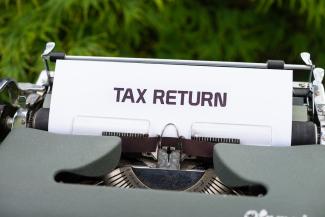
3 Common Tax Myths, Debunked
Tax season is here again! While some people dread finding out that they owe the government more money, others are eagerly awaiting their refund. With so many provisions in the tax law, it's no wonder that most people don't fully understand how taxes work. Here are some common misconceptions that we've heard over the years.
1. "My friend got a bigger tax refund than I did, so they must pay lower taxes."
Although we only file a tax return once a year, the United States is actually a pay-as-you-go system. Most people, while working, have taxes withheld from each of their paychecks throughout the year. For others, they may need to either set up tax withholding from their investments or pay quarterly tax estimates.
At tax time, we calculate how much in tax we truly owe after all deductions and credits - information your employer wouldn't reasonably be expected to know when they calculate how much to withhold from your paychecks. Therefore, a tax refund in the spring means that we withheld too much throughout the year (and inversely, a tax bill means that you didn't withhold enough). Receiving a larger refund isn't an indication that one person paid less in taxes than another - just that their withholding during the year was much higher than their actual tax bill.
2. "I'm in the 24% tax bracket, so that means all of my money is taxed at 24%."
When people refer to their "tax bracket," they are usually referring to their Marginal Tax Rate; the rate at which your highest dollar of income is taxed. However, the US has a progressive tax system, meaning that your income is taxed at different rates as you move through the brackets.
The best way to explain this is through an example. In 2022, a single taxpayer with a Taxable Income of $50,000 would fall into the 22% tax bracket. However, this does NOT mean that they pay $11,000 in taxes (which is 22% of $50,000). Instead, they actually experience the 10% and 12% brackets before reaching 22%.
|
Income on... |
Is taxed at… |
Resulting in a tax of… |
|
The first $10,275 |
10% |
$1,027.50 |
|
$10,276 - $41,775 |
12% |
$3,780.00 |
|
$41,775 - $50,000 |
22% |
$1,809.50 |
|
|
|
$6,617.00 total tax bill |
As you can see, the total tax bill is much smaller than 22%. In fact, $6,617 is just 13.23% of $50,000; this is known as the Effective Tax Rate. In this example, if the individual earns another dollar, it will be taxed at 22%; however, this isn't the same as saying that all of their income is taxed at 22%.
3. "It's after December 31st, so there's nothing I can do to affect my 2022 taxes now."
This depends on your situation! While it's true that some actions must be completed within the tax year, others can be completed up to your tax deadline. Ask your accountant:
- Are you eligible to make a 2022 HSA contribution? These are deductible, but require that you were enrolled in a high-deductible health plan in 2022. There is a limit to how much you can contribute, and the accounts may incur penalties if not used for healthcare-related expenses.
- Can you make a 2022 deductible IRA contribution? This depends on your income and whether or not you had a retirement plan at work, and like an HSA, there is a contribution limit.
- Are you eligible for a 2022 Roth IRA contribution, or a "back-door Roth?" While these would not reduce your taxes for 2022, they may help reduce future tax bills.
As always, this article is meant to be informational and is not specific to your situation. It is not intended to give tax advice; please consult with your tax advisor if you have questions and before you take any action. Additionally, while there are limited actions that you can take at this time to impact your 2022 taxes, proper tax planning by year-end may provide benefits for either your 2023 return, or for future tax years. A few additional questions you may ask your tax advisor:
- Could I benefit from a Roth Conversion in 2023?
- Could a Donor Advised Fund help make my charitable contributions more effective?
- Is there any way to make my investment accounts more tax-efficient?
As always, please call us or use the form below to contact us with any questions. We wish you the best through tax season!


